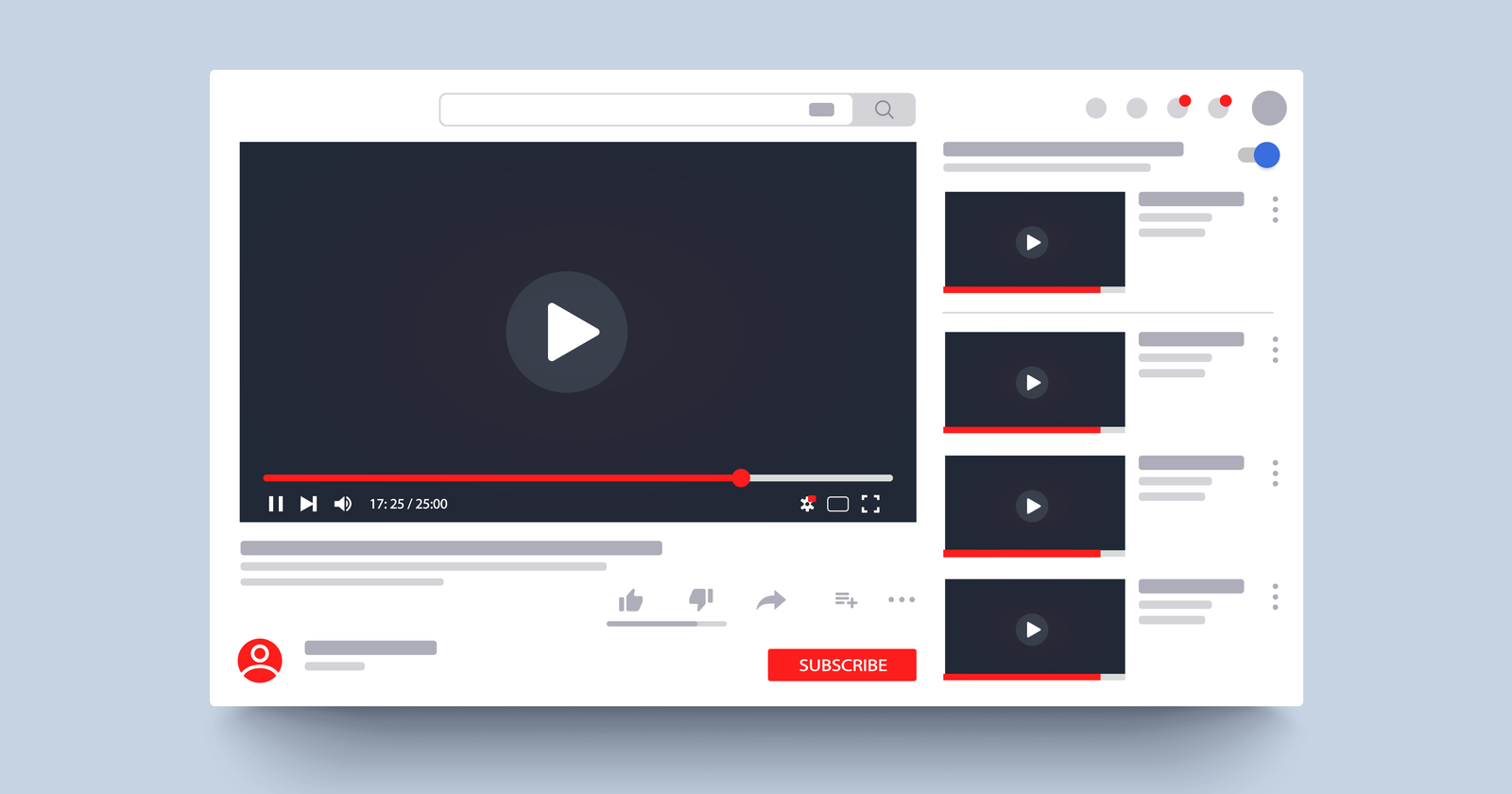YouTube SEO can help your content reach a wider audience by actively targeting people who are searching for your videos.
First, you have to identify what topics people are searching for.
Then, you need to know why YouTube ranks videos the way it does.
Finally, you’ll learn how to put what you learned into practice.
This article will cover all three pillars of YouTube SEO, and teach you how to position your videos to rank ahead of rivals.
Introduction To YouTube SEO
Video content is an unrivaled tool when it comes to telling a story to the masses, and it’s only growing in popularity as more advanced technology continues to hit the market.
Human beings have pretty much always enjoyed — sometimes even relied on — video content. Fun fact: movies helped pull us out of the Great Depression.
Video has only become more common (Hello, Internet!), useful, and better-produced since then. Today, YouTube is accessible in just seconds to anyone from nearly anywhere in the world.
But now, with so many people uploading video to the web and all the video content that is already living on the internet — increasing drastically in volume every day — how can marketers get their content to stand out against “the other guys?”
Use these basic and advanced tips to help you and your content team succeed against other video publishers that aren’t taking advantage of the video optimization tactics.
1. Identify Target Keywords
Like optimizing a webpage for Google, optimizing a video for YouTube’s search results begins with keyword research.
By prioritizing this step of the YouTube SEO process you can ensure you’re creating and optimizing content people are actually looking for.
The first phase of keyword research starts on YouTube itself. There’s a goldmine of data within the search bar, as the autosuggestions reflect genuine user queries.
Start typing a word or phrase related to your niche and you’ll see a list of trending keywords:
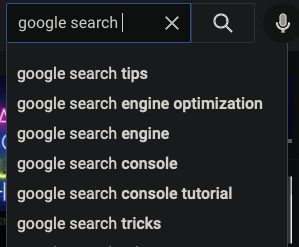 Screenshot from YouTube.com, September 2021.
Screenshot from YouTube.com, September 2021.Now click on a suggestion that you can make an interesting video about and see which channels are already ranking.
There’s a lot to learn from these channels if you know where to look. Start by browsing their most popular videos.
Visit a channel’s page and you’ll immediately see a section dedicated to their highest performing content.
This is a good source of keyword inspiration because you’re getting ideas from videos proven to be a hit with viewers.
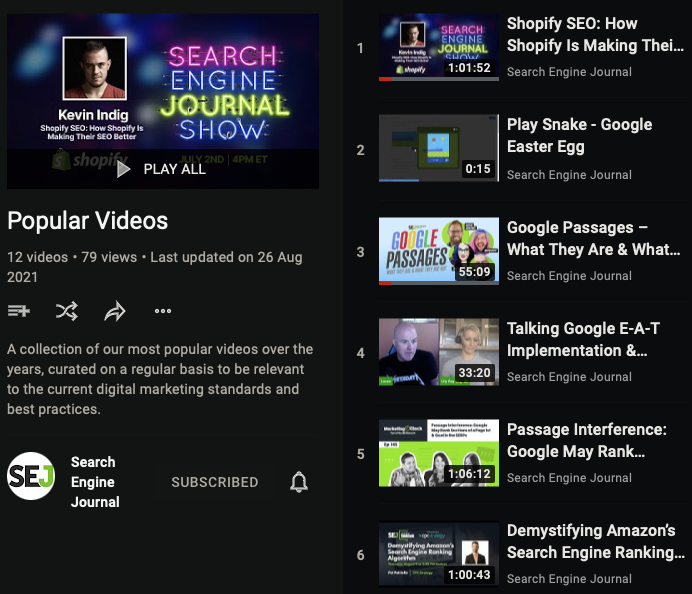 Screenshot from YouTube.com, September 2021.
Screenshot from YouTube.com, September 2021.Using the example above, let’s say you’ve chosen “Google Easter egg” as the potential topic for your next video.
So far, all signs indicate that’s a good keyword. But we need further confirmation to be absolutely sure.
We need to know people are actively searching for the topic, and that YouTube isn’t saturated with videos about it already.
You can check to make sure your keyword isn’t too competitive by searching for it in Google.
Using the ‘site:’ command you can get an idea how many videos about that topic are on YouTube already.
The lower the better. If your search returns over 500K results, I’d recommend starting over and picking a new one.
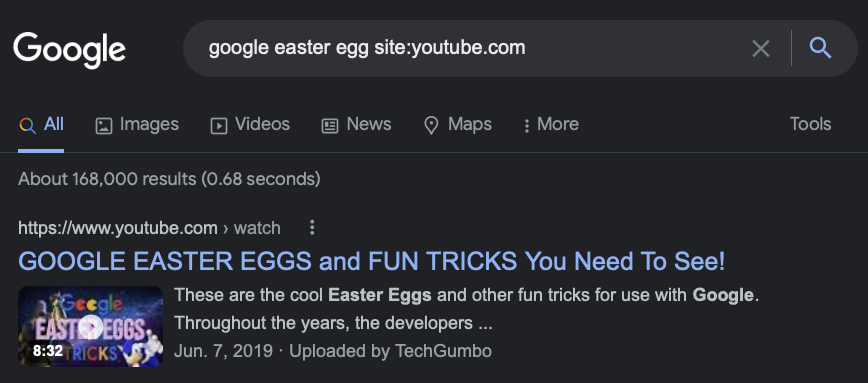 Screenshot from YouTube.com, September 2021.
Screenshot from YouTube.com, September 2021.In the screenshot above we can see there’s approximately 168K videos about “Google Easter egg” on YouTube. That means it gets the green light to go ahead to the next phase.
The last step of the keyword research process involves a familiar tool: Google Keyword Planner.
Why?
YouTube isn’t the only place people find videos, they’re also surfaced in Google’s search results. So you want to choose a keyword that’s viable for both search engines.
Again, the goal is to find a keyword that people are looking for but isn’t overly competitive. To hit that sweet spot, the ideal number of average monthly searches in Google Keyword Planner is 1K or less.
Following the same example, let’s see if “Google Easter egg” passes the final test.
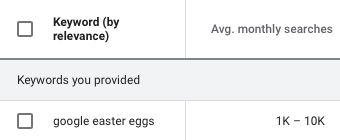 Screenshot from Ads.Google.com, September 2021.
Screenshot from Ads.Google.com, September 2021.It does! This keyword is on the higher end of average monthly searches, but it passes nonetheless.
“Google Easter egg” meets all criteria for a good keyword, so it has a high chance of performing well on YouTube.
Before we get into how to optimize YouTube videos, it’s important to understand the factors you’re optimizing for and why. The next section goes over the ranking factors for YouTube’s algorithm.
2. Understanding YouTube SEO Ranking Factors
The first thing to understand about optimizing videos is YouTube has two algorithms.
There’s the recommendation algorithm, which ranks content on YouTube’s home page and suggested videos sections.
And there’s the search algorithm, which ranks content in YouTube’s search results.
This section, and all information going forward in this article, refers to YouTube’s search algorithm. For details on how YouTube suggests videos to users, see Search Engine Journal’s guide to the YouTube recommendation algorithm.
While are several ranking factors shared between both algorithms, it’s important to note the difference.
With that distinction made, let’s get into the meat of this section.
YouTube Search Ranking Factors
YouTube’s search algorithm prioritizes these four factors when ranking videos in search results:
- Relevance: Include factors such as the title, hashtags, description, and video content itself.
- Engagement: Includes factors such as likes, subscribes, comments, turning on notifications, and watch time.
- Quality: Includes signals that can help determine which channels demonstrate expertise, authoritativeness, and trustworthiness on a given topic.
- Personalization: YouTube tries to find the most relevant results for each user by taking into account a user’s search and watch history.
YouTube’s algorithm prioritizes content from trusted authorities for searches related to news, politics, and medical or scientific information.
For other categories, such as music or entertainment, YouTube is more likely to look at signals like relevance, freshness, or popularity.
Be careful not to think about YouTube SEO like Google SEO, as user interaction signals are not taken into account by Google’s algorithm.
Whether people click on the results Google surfaces is irrelevant to its algorithm. It aims to serve the most relevant results, regardless of how many people visit those pages.
That’s not the case for YouTube.
YouTube’s algorithm aims to serve the most satisfying results.
To determine which videos are most satisfying, YouTube considers how other users interacted with them when the videos were shown in search results.
- Did they watch the whole way through?
- Did they like the video?
- Did they leave a comment?
- Did they subscribe to the channel?
- Did they turn on notifications?
- Did they watch even more of the channel’s videos?
These are all strong ranking signals for YouTube’s search algorithm.
The optimization tips in the next section will help YouTube understand what your videos are about. To take your videos to the top of the SERPs you need to create satisfying content that encourages user engagement.
3. Putting YouTube SEO Into Practice
There’s a reason why YouTube lets users manually input a title, description, and tags, as well as choose an optimal video thumbnail and add the new video to a playlist.
It’s all about making it easy for your audience to find you.
All those options should be utilized from the first time the video is uploaded, with the exception of maybe adding it to a playlist – that can wait until the appropriate playlist(s) is created, adding even more visibility to your video.
Title
Use keywords to focus on user intent and how those keywords match up with what the video content actually offers users.
Don’t worry about adding brand names to your titles (that’s usually already the channel name anyway). Focus on the important elements.
Use keyword research to get the most out of all basic YouTube publishing features where you can leverage keywords and relevancy.
You only have about 65-70 characters (including spaces) to say what’s important, so be sure to use that valuable real estate to capitalize.
YouTube allows 100 characters with spaces, but titles will be truncated depending on where they are showing up.
The title is one of the first things users see when your video appears on a page, shows up in search, or is shared on social media. Make it count.
Description
Like your title, your description contains keywords, reflects the content in the video, and is one of the first things a user sees.
Remember that you’re constructing a description of the video, not an advertisement or promotion.
A quality description has more details than a title, but shouldn’t be too long.
Your description should entice a user to watch the video because the information given leads the person to believe the video was something they were looking for.
The description should also include at least one link, typically back to the brand website, perhaps to a page specific to the content in the video.
I consider two links in a description a sweet spot (one at end of the first sentence and one in the last sentence), but keep in mind it’s a way to give users more information. You shouldn’t drown out a link or two with five links adding no real value.
I always recommend the following:
- Write a two- to three-sentence description.
- Add at least one link.
- Keep it around 300 characters, including spaces, or less.
YouTube allows 5000 characters, but by no means do you need to use them all. In fact, you probably shouldn’t.
Hashtags
Tags are fairly new to YouTube and are helpful for classifying content.
Only use keywords that are actually relevant to your video. Don’t add irrelevant tags in the hopes you’ll get more visibility (you won’t – or, if you do, you’ll only anger your viewers).
Hashtags help users and Google (and other search engines) better understand your video content.
Thumbnail
This is pretty simple. Pick an enticing picture.
Don’t pick something of a title slide or anything diluted by writing; pick a still image that users are going to be interested in and could possibly generate lots of clicks.
Again, don’t do anything tricky in an attempt to deceive users.
Playlist
Use these to get expanded reach and visibility on your videos.
However, there’s little-to-no pressure to get videos added to playlists – especially right away.
You can find all of the above-listed optimization options directly after uploading a video:
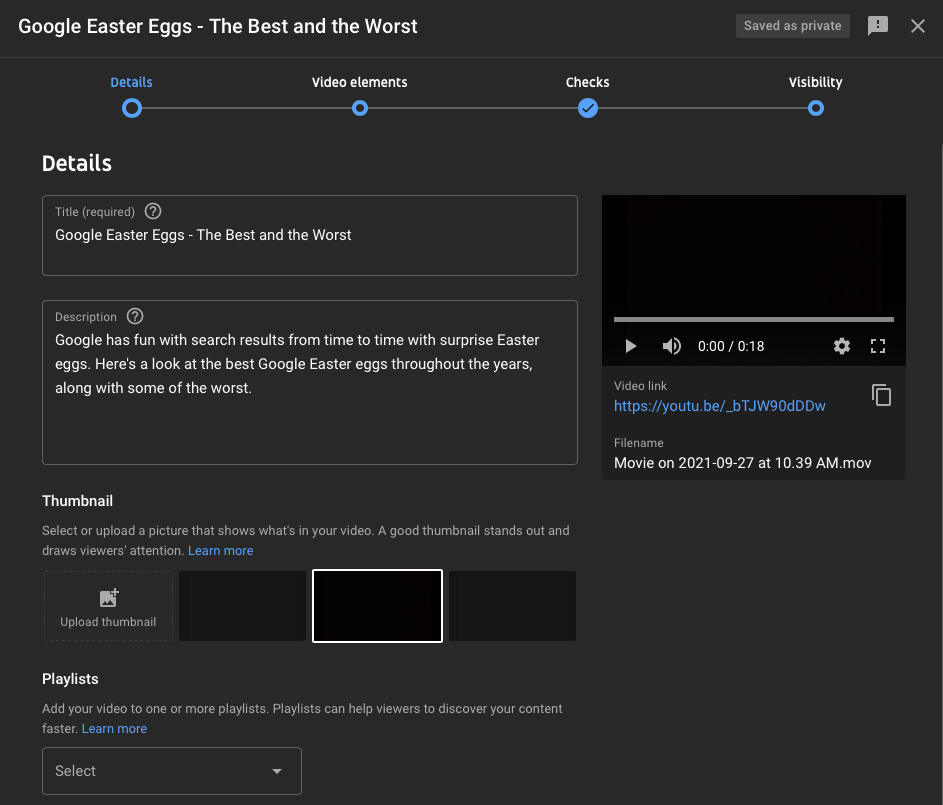 Screenshot from Studio.YouTube.com, September 2021.
Screenshot from Studio.YouTube.com, September 2021.Translations
YouTube offers content creators the ability to translate videos into other languages.
This is useful when publishing global content intended for an international audience or when directed a specific demographic target that speaks a different language than English.
Most U.S.-based brands shouldn’t need this, but the instructions to translate are easy to follow if/when you do.
Language
If you’re uploading a video in English, and most or all your videos are going to be in English, select it from the Original language drop-down.
 Screenshot from Studio.YouTube.com, September 2021.
Screenshot from Studio.YouTube.com, September 2021.Advanced Settings
YouTube’s advanced settings offer a variety of options for video optimizations.
Some may seem sensible – others, not so much.
Here are which advanced settings changes you should make for your video and how to do it.
Comments
While it seems like a gift from the internet Gods to be able to disable all comments on a video, it will actually hurt your video’s visibility quite significantly.
Comments are one of the signals used by YouTube to determine relevancy, quality, and recency of videos.
Be sure comments are allowed by selecting the option from the drop-down menu.
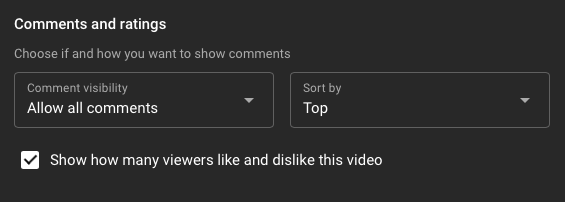 Screenshot from Studio.YouTube.com, September 2021.
Screenshot from Studio.YouTube.com, September 2021.Distribution Rights
Allowing embedding of your video is going to likely increase the rate at which it is shared and embedded since it gives users the best on-site experience.
Anyone could add it to their website, including a news station or blogger.
Publishing the video to the Subscriptions feeds and notifying subscribers is also a default best practice that helps the video be found and watched.
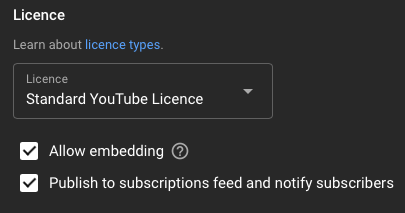 Screenshot from Studio.YouTube.com, September 2021.
Screenshot from Studio.YouTube.com, September 2021.Age Restrictions
Videos shouldn’t have age restrictions added, unless there is explicit content that requires it.
What defines explicit may vary from person to person but “violence, disturbing imagery, nudity, sexually suggestive content, and portrayal of dangerous or illegal activities” may all be worth age restrictions, according to YouTube.
When age restriction is activated, all viewers must be signed into YouTube and over the age of 18.
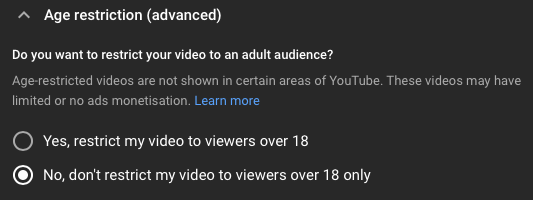 Screenshot from Studio.YouTube.com, September 2021.
Screenshot from Studio.YouTube.com, September 2021.Category
There are 15 different categories to choose from, and it helps YouTube recommend a video based on content criteria and other users’ behavior.
Most videos should have a category they match up with quite literally, but if for some reason a video can’t easily be categorized, I recommend using the default “Entertainment” tag.
 Screenshot from Studio.YouTube.com, September 2021.
Screenshot from Studio.YouTube.com, September 2021.Additional YouTube SEO All Videos Should Have
In addition to the above optimization techniques, some other basic optimizations can help make your videos more visible, but also perform better in general:
Include a Clear Call-To-Action (CTA)
Many great videos’ impact and engagement end when the video does. Don’t let that be the case.
Offer viewers clear next steps so that they can:
- Learn more about the video.
- Proceed to your website and learn more about the brand and what it has to offer.
- Potentially convert as a referral visitor from YouTube.
YouTube annotations are a great tool to use for CTAs.
Don’t Try to Oversell Yourself
YouTube is a place for people to educate themselves and feel inspired; rarely are users trying to be sold products, or even on brands.
Transcribe Your Content
This is oftentimes overlooked because it’s a tedious and laborious task, but it helps YouTube and search engines better understand the video and its content better than any other way.
It’s like crawling a website; you can’t crawl a video the same way you can text.
Distribute Your Content
Content should be shared across all social channels and in relevant communities and forums to extend reach.
It’s also worthwhile to put ad dollars behind the video content, as the more eyes that watch it, the better it performs.
Get the ball rolling out of the gate with optimized content, and you should see consistent video success for your content and your channel.
Content That Wins on YouTube & Why
Remember, there are a variety of signals that go into YouTube rankings and visibility:
- Watch time: How long a viewer watches a video.
- Keywords: Illustrate relevance to a search query.
- Subscribers: A channel with hundred or thousands of subscribers is going to perform better than a channel with 15 subscribers. This is a behavioral signal signifying the channel is an authority on certain topics and trusted by others.
- Engagement: Likes, dislikes, and comments are all helpful signals that help YouTube, Google, and other search engines realize a video is worthy of more visibility.
- Video length: YouTube content shouldn’t be too long. Users should be interested in the content and watch it to get the real value from it.
Summary
An optimized YouTube video is one that:
- Is relevant to the user and/or their search query.
- Includes relevant keywords.
- Engages users, compelling them to watch most, if not all, of the video.
- Has a clear CTA.
- Includes at least one link that points to a relevant site for more information.
These optimizations are easy, straightforward, and helpful when producing quality video content that should be distributed.
And they make all the difference.
More YouTube SEO Resources:
- How to Do Keyword Research for SEO: The Ultimate Guide
- 6 YouTube SEO Tips Based on Google’s Published Paper
- How to Get More Views on YouTube: Experts Share Tips
Featured Image: FellowNeko / Shutterstock



